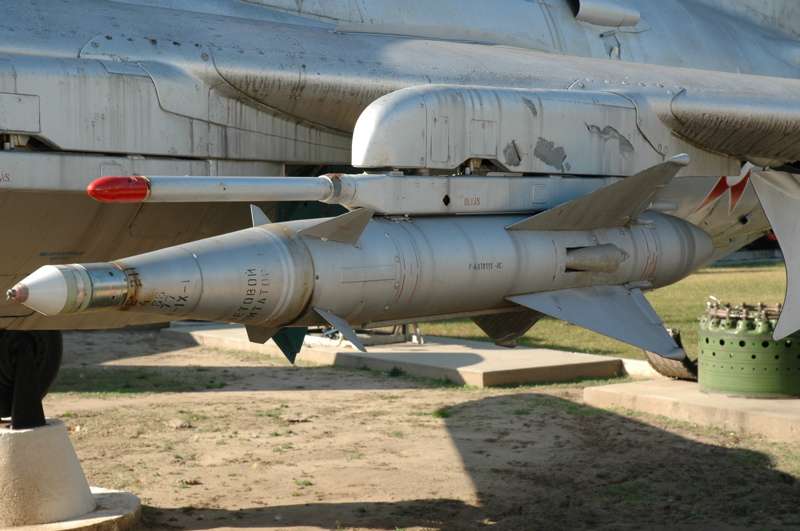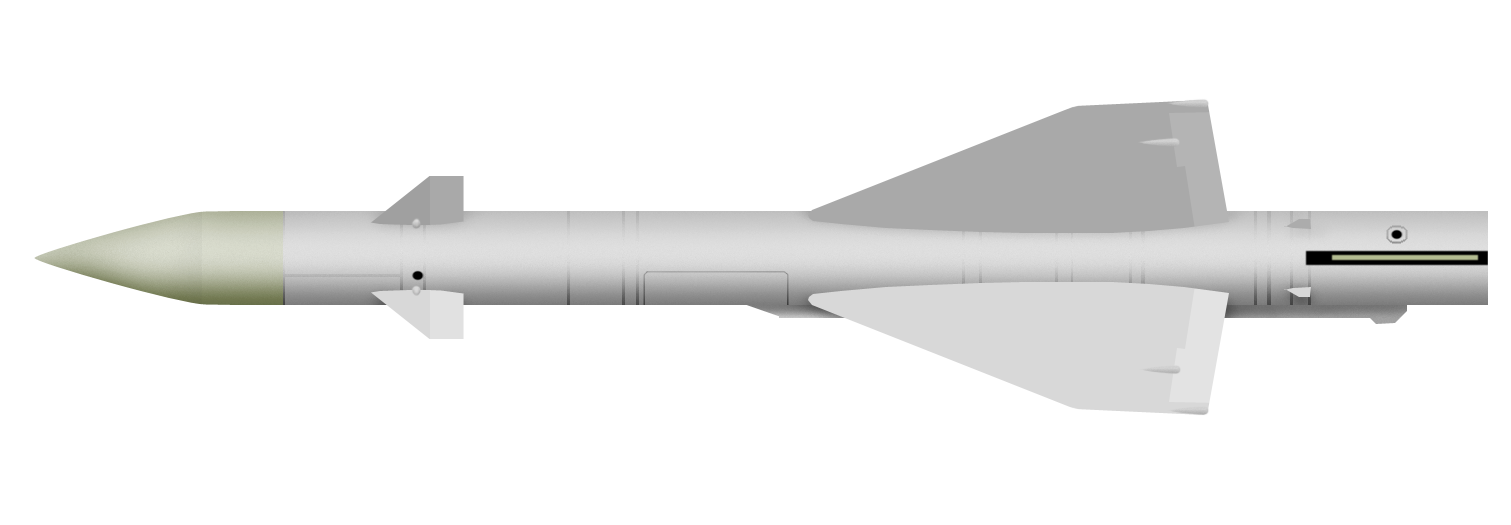|
Kh-23
The Zvezda Kh-66 and Kh-23 ''Grom'' (russian: Х-23 Гром 'Thunder'; NATO: AS-7 'Kerry') are a family of early Soviet tactical air-to-surface missiles with a range of 10 km. They were intended for use against small ground or naval targets. The Kh-66 was effectively a heavy-warhead, beam-riding version of the K-8 (AA-3 'Anab') air-to-air missile rushed into service in Vietnam in 1968. The Kh-23 was an improved Kh-66 with command-guidance, similar to the AGM-12 Bullpup. Development Work on air-to-air missiles had started at the Kaliningrad Engineering Plant (then known as Plant #455, and later merged into Zvezda-Strela) in 1955. This had resulted in the Kaliningrad K-5 (AA-1 'Alkali') family of beam-guided missiles, including the K-51 (RS-2-US) carried by the Su-9 'Fishpot'. OKB-4 Molniya (later Vympel NPO) under Matus Bisnovat would go on to produce missiles such as the AA-6 Acrid. Meanwhile, in 1963 the RS-2-US was tested as an air-to-surface missile. It was concluded t ... [...More Info...] [...Related Items...] OR: [Wikipedia] [Google] [Baidu] |
Kh-25
The Kh-25/Kh-25M (russian: Х-25; NATO: AS-10 'Karen) is a family of Soviet lightweight air-to-ground missiles with a modular range of guidance systems and a range of 10 km. The anti-radar variant (Kh-25MP) is known to NATO as the AS-12 ' Kegler and has a range up to 40 km. Designed by Zvezda-Strela, the Kh-25 is derived from the laser-guided version of the Kh-23 Grom (AS-7 'Kerry'). The Kh-25 remains in widespread use despite the apparent development of a successor, the Kh-38. Development Based on an air-to-air missile, the beam-riding Kh-66 had been the Soviet Union's first air-to-ground missile for tactical aircraft, entering service in 1968. However it proved difficult to use in practice as the launch aircraft had to dive towards the target. A version with radio-command guidance, the Kh-23, was first tested in 1968 but problems with the guidance system meant that it would not enter service for another five years. So in 1971 work began on a version with a semi-act ... [...More Info...] [...Related Items...] OR: [Wikipedia] [Google] [Baidu] |
MiG-23
The Mikoyan-Gurevich MiG-23 (russian: Микоян и Гуревич МиГ-23; NATO reporting name: Flogger) is a variable-geometry fighter aircraft, designed by the Mikoyan-Gurevich design bureau in the Soviet Union. It is a third-generation jet fighter, alongside similar Soviet aircraft such as the Su-17 "Fitter". It was the first Soviet fighter to field a look-down/shoot-down radar, the RP-23 Sapfir, and one of the first to be armed with beyond-visual-range missiles. Production started in 1969 and reached large numbers with over 5,000 aircraft built, making it the most produced variable-sweep wing aircraft in history. Today the MiG-23 remains in limited service with some export customers. The basic design was also used as the basis for the Mikoyan MiG-27, a dedicated ground-attack variant. Among many minor changes, the MiG-27 replaced the MiG-23's nose-mounted radar system with an optical panel holding a laser designator and a TV camera. Development The MiG-23's predece ... [...More Info...] [...Related Items...] OR: [Wikipedia] [Google] [Baidu] |
Su-17
The Sukhoi Su-17 (''izdeliye'' S-32) is a variable-sweep wing fighter-bomber developed for the Soviet Union, Soviet military. Its NATO reporting name is "Fitter". Developed from the Sukhoi Su-7, the Su-17 was the first variable-sweep wing aircraft to enter Soviet service. Two subsequent Sukhoi aircraft, the Su-20 and Su-22, have usually been regarded as variants of the Su-17. The Su-17/20/22 series has had a long career and has been operated by many other air forces of including the Russia, Russian Federation, other former Soviet republics, the former Warsaw Pact, countries in the Arab world, Angola and Peru. Development Shortly after the Su-7 fighter-bomber was put into service, the Sukhoi Design Bureau was ordered to develop a deep modernization program for the aircraft in the early 1960s. The program would be aimed primarily at updating on-board avionics and the takeoff/landing performance characteristics. The concept of variable-geometry wings - something gaining wider at ... [...More Info...] [...Related Items...] OR: [Wikipedia] [Google] [Baidu] |
Air-to-surface Missile
An air-to-surface missile (ASM) or air-to-ground missile (AGM) is a missile designed to be launched from military aircraft at targets on land or sea. There are also unpowered guided glide bombs not considered missiles. The two most common propulsion systems for air-to-surface missiles are rocket motors, usually with shorter range, and slower, longer-range jet engines. Some Soviet-designed air-to-surface missiles are powered by ramjets, giving them both long range and high speed. Guidance for air-to-surface missiles is typically via laser guidance, infrared guidance, optical guidance or via satellite guidance A guided bomb (also known as a smart bomb, guided bomb unit, or GBU) is a precision-guided munition designed to achieve a smaller circular error probable (CEP). The creation of precision-guided munitions resulted in the retroactive renaming of ... signals. The type of guidance depends on the type of target. Ships, for example, may be detected via passive radar or ... [...More Info...] [...Related Items...] OR: [Wikipedia] [Google] [Baidu] |
Grom (missile)
The Grom (meaning "thunder" in Polish) is a man-portable air-defense system produced in Poland and based on the Soviet man-portable infrared homing surface-to-air missile (SAM) 9K38 Igla. It consists of a 72 mm anti-aircraft missile set with a flight speed of 650 m/s, as well as a single-use launcher, re-usable gripstock and thermal battery coolant assembly electric unit. The full name of the system is PZR Grom, PZR standing for ''Przeciwlotniczy Zestaw Rakietowy'' (literally anti-air rocket-propelled set). It is designed to target low-flying helicopters and aeroplanes. As such, the Grom missile is used by other surface-to-air defence systems of Polish design, including ZSU-23-4MP Biała, ZUR-23-2 kg and Poprad self-propelled artillery system. It should not to be confused with versions of the Zvezda Kh-23 air-to-surface missile built under licence in Yugoslavia/Serbia as the Grom-A and Grom-B. History Initially at least since the 1970s the MESKO metal works in ... [...More Info...] [...Related Items...] OR: [Wikipedia] [Google] [Baidu] |
MiG-27
The Mikoyan MiG-27 (russian: Микоян МиГ-27; NATO reporting name: Flogger-D/J) is a variable-sweep ground-attack aircraft, originally built by the Mikoyan-Gurevich design bureau in the Soviet Union and later licence-produced in India by Hindustan Aeronautics as the ''Bahadur'' ("Valiant"). It is based on the Mikoyan-Gurevich MiG-23 fighter aircraft, but optimised for air-to-ground attack. Unlike the MiG-23, the MiG-27 did not have widespread use outside Russia, as most countries opted for the Mikoyan-Gurevich MiG-23BN and Sukhoi Su-22 instead. It remains in service only with the Kazakh Air Forces in the ground attack role. All Russian, Indian, Sri Lankan and Ukrainian MiG-27s have been retired. Design and development The MiG-27 shares the basic airframe of the MiG-23, but with a revised nose – nicknamed "''Utkonos''" ("Platypus") or "'' Krokodil Gena''" in Russian service, first introduced on the MiG-23B. Dissatisfaction with the MiG-23BN led to the further deve ... [...More Info...] [...Related Items...] OR: [Wikipedia] [Google] [Baidu] |
AGM-12 Bullpup
The AGM-12 Bullpup is a short-range air-to-ground missile developed by Martin Marietta for the US Navy. It is among the earliest precision guided air-to-ground weapons and the first to be mass produced. It first saw operational use in 1959 on the A-4 Skyhawk, but soon found use on the A-6 Intruder, F-100 Super Sabre, F-105 Thunderchief, F-4 Phantom II, F-8 Crusader, and P-3 Orion in both Navy and US Air Force service, as well as NATO allies. The weapon was guided manually via a small joystick in the aircraft cockpit, which presented a number of problems and its ultimate accuracy was on the order of , greater than desired. In the 1960s it was increasingly supplanted by fully automatic weapons like the AGM-62 Walleye and AGM-65 Maverick. History ASM-N-7 Bullpup Development of Bullpup began in 1953 when Korean War experience demonstrated the almost complete inability for conventional bombing to attack point land targets like bridges. There had been great experimentation during Wo ... [...More Info...] [...Related Items...] OR: [Wikipedia] [Google] [Baidu] |
Kamov Ka-29
The Kamov Ka-27 ( NATO reporting name 'Helix') is a military helicopter developed for the Soviet Navy, and currently in service in various countries including Russia, Ukraine, Vietnam, China, South Korea, and India. Variants include the Ka-29 assault transport, the Ka-28 downgraded export version, and the Ka-32 for civilian use. Design and development The helicopter was developed for ferrying and anti-submarine warfare. Design work began in 1969 and the first prototype flew in 1973. It was intended to replace the decade-old Kamov Ka-25, and had to have identical or inferior external dimensions compared to its predecessor. Like other Kamov military helicopters it has coaxial rotors, removing the need for a tail rotor. In total, five prototypes and pre-series helicopters were built. Series production started at Kumertau in July 1979, and the new helicopter officially entered service with the Soviet Navy in April 1981. The Ka-27 has a crew of three with a pilot and a navigato ... [...More Info...] [...Related Items...] OR: [Wikipedia] [Google] [Baidu] |
Vietnam War
The Vietnam War (also known by #Names, other names) was a conflict in Vietnam, Laos, and Cambodia from 1 November 1955 to the fall of Saigon on 30 April 1975. It was the second of the Indochina Wars and was officially fought between North Vietnam and South Vietnam. The north was supported by the Soviet Union, China, and other communist states, while the south was United States in the Vietnam War, supported by the United States and other anti-communism, anti-communist Free World Military Forces, allies. The war is widely considered to be a Cold War-era proxy war. It lasted almost 20 years, with direct U.S. involvement ending in 1973. The conflict also spilled over into neighboring states, exacerbating the Laotian Civil War and the Cambodian Civil War, which ended with all three countries becoming communist states by 1975. After the French 1954 Geneva Conference, military withdrawal from Indochina in 1954 – following their defeat in the First Indochina War – the Viet Minh to ... [...More Info...] [...Related Items...] OR: [Wikipedia] [Google] [Baidu] |
Kaliningrad K-8
The Kaliningrad K-8 (R-8) (NATO reporting name AA-3 'Anab') was a medium-range air-to-air missile developed by the Soviet Union for interceptor aircraft use.Gordon, Yefim. ''Soviet/Russian Aircraft Weapons''. Midland. 2004. The missile was developed by OKB-339/NII-339 (currently Phazotron, Phazotron NIIR). The infrared seeker was developed by TsKB-589 GKOT (currently TsKB Geofizika), who also developed the seeker for 9M31 missile of 9K31 Strela-1. History The K-8's development began in 1955, known as R-8 in service. Like most Soviet air-to-air missiles, it was made with a choice of semi-active radar homing or infrared homing, infrared seeker heads. The original missile was compatible with the Uragan-5B radar used on the Sukhoi Su-11 and several developmental aircraft from Mikoyan-Gurevich. It was upgraded to R-8M (better known as R-98) standard in 1961, giving the SARH weapon the capability for head-on intercepts. In 1963 it was further upgraded to the R-8M1, making it compatibl ... [...More Info...] [...Related Items...] OR: [Wikipedia] [Google] [Baidu] |
Mikoyan-Gurevich MiG-21
The Mikoyan-Gurevich MiG-21 (russian: Микоян и Гуревич МиГ-21; NATO reporting name: Fishbed) is a supersonic jet aircraft, jet fighter aircraft, fighter and interceptor aircraft, designed by the Mikoyan, Mikoyan-Gurevich OKB, Design Bureau in the Soviet Union. Its nicknames include: "balalaika", because its planform (aeronautics), planform resembles the balalaika, stringed musical instrument of the same name; "''Ołówek''", Polish language, Polish for "pencil", due to the shape of its fuselage, and "''Én Bạc''", meaning "silver swallow", in Vietnamese language, Vietnamese. Approximately 60 countries across four continents have flown the MiG-21, and it still serves many nations six decades after its maiden flight. It set aviation records, becoming List of most-produced aircraft, the most-produced supersonic jet aircraft in aviation history, the most-produced combat aircraft since the Korean War and, previously, the longest production run of any combat air ... [...More Info...] [...Related Items...] OR: [Wikipedia] [Google] [Baidu] |
NATO Reporting Name
NATO reporting names are code names for military equipment from Russia, China, and historically, the Eastern Bloc (Soviet Union and other nations of the Warsaw Pact). They provide unambiguous and easily understood English words in a uniform manner in place of the original designations, which either may have been unknown to the Western world at the time or easily confused codes. For example, the Russian bomber jet Tupolev Tu-160 is simply called "Blackjack". NATO maintains lists of the names. The assignment of the names for the Russian and Chinese aircraft was once managed by the five-nation Air Standardization Coordinating Committee (ASCC), but that is no longer the case. American variations The United States Department of Defense (DOD) expands on the NATO reporting names in some cases. NATO refers to surface-to-air missile systems mounted on ships or submarines with the same names as the corresponding land-based systems, but the US DoD assigns a different series of numbers with ... [...More Info...] [...Related Items...] OR: [Wikipedia] [Google] [Baidu] |

.jpg)





.png)



